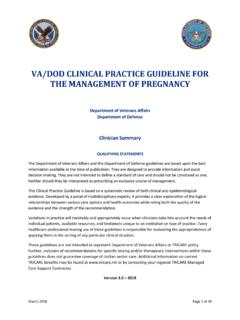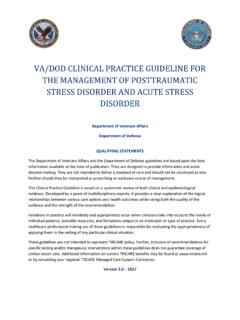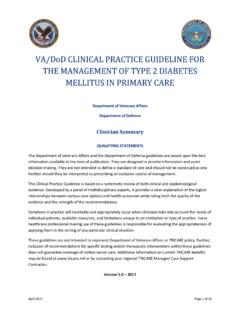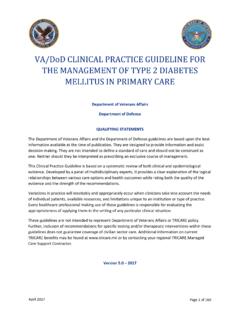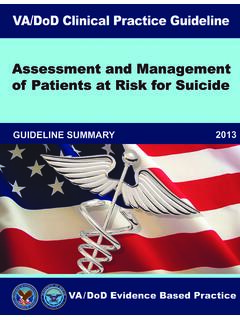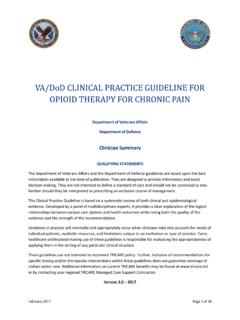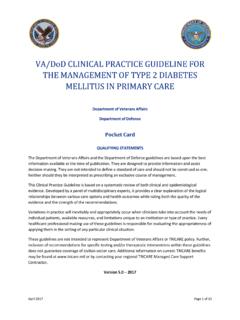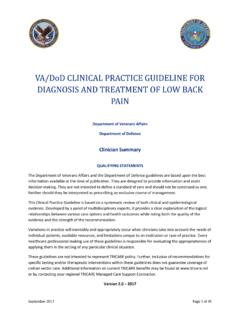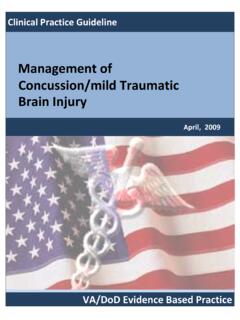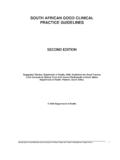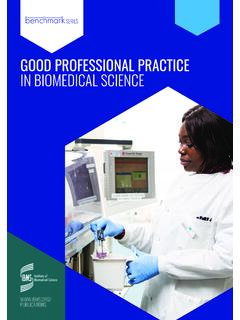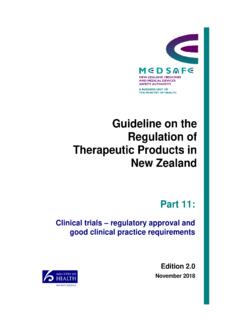Transcription of VA/DoD Clinical Practice Guideline for the Management of ...
1 VA/DoD Clinical Practice Guideline FOR. THE Management OF POSTTRAUMATIC. STRESS DISORDER AND ACUTE STRESS. DISORDER. Department of Veterans Affairs Department of Defense Clinician Summary QUALIFYING STATEMENTS. The Department of Veterans Affairs and the Department of Defense guidelines are based upon the best information available at the time of publication. They are designed to provide information and assist decision making. They are not intended to define a standard of care and should not be construed as one. Neither should they be interpreted as prescribing an exclusive course of Management . The Clinical Practice Guideline is based on a systematic review of both Clinical and epidemiological evidence. Developed by a panel of multidisciplinary experts, it provides a clear explanation of the logical relationships between various care options and health outcomes while rating both the quality of the evidence and the strength of the recommendation.
2 Variations in Practice will inevitably and appropriately occur when clinicians take into account the needs of individual patients, available resources, and limitations unique to an institution or type of Practice . Every healthcare professional making use of these guidelines is responsible for evaluating the appropriateness of applying them in the setting of any particular Clinical situation. These guidelines are not intended to represent TRICARE policy. Further, inclusion of recommendations for specific testing and/or therapeutic interventions within these guidelines does not guarantee coverage of civilian sector care. Additional information on current TRICARE benefits may be found at or by contacting your regional TRICARE Managed Care Support Contractor. Version 2017. VA/DoD Clinical Practice Guideline for the Management of Posttraumatic Stress Disorder Clinician Summary Table of Contents I.
3 3. II. How to Use the Clinical Practice Guideline .. 3. III. Recommendations .. 5. A. Grading 8. IV. Algorithm .. 10. Module A: Acute Stress Reaction/Disorder .. 11. Module B: Assessment and Diagnosis of Posttraumatic Stress Disorder .. 13. Module C: Management of Posttraumatic Stress Disorder .. 15. V. Scope of the Clinical Practice Guideline .. 16. VI. Guideline Work Group .. 16. VII. Recommendation Discussion .. 17. A. General Clinical Management .. 17. a. Patient-centered Care .. 17. b. Shared Decision Making .. 17. c. Collaborative Care .. 18. B. Diagnosis and Assessment of Posttraumatic Stress Disorder .. 18. C. Prevention of Posttraumatic Stress Disorder .. 19. a. Selective Prevention of Posttraumatic Stress 19. b. Indicated Prevention of Posttraumatic Stress Disorder and Treatment of Acute Stress Disorder .. 19. D. Treatment of Posttraumatic Stress Disorder.
4 19. a. Treatment Selection .. 19. b. Psychotherapy .. 20. c. Pharmacotherapy .. 21. d. Augmentation Therapy .. 24. e. 24. f. Combination Therapy .. 25. g. Non-pharmacologic Biological Treatments .. 25. h. Complementary and Integrative Treatments .. 25. i. Technology-based Treatment Modalities .. 26. E. Treatment of Posttraumatic Stress Disorder with Co-occurring Conditions .. 26. a. Background on Co-occurring Conditions with Posttraumatic Stress 26. Appendix A: Pharmacotherapy Dosing Table .. 29. References .. 30. June 2017 Page 2 of 34. VA/DoD Clinical Practice Guideline for the Management of Posttraumatic Stress Disorder Clinician Summary I. Introduction The Department of Veterans Affairs (VA) and the Department of Defense (DoD) Evidence-Based Practice Work Group (EBPWG) was established and first chartered in 2004, with a mission to advise the Health Executive Council on the use of Clinical and epidemiological evidence to improve the health of the population across the Veterans Health Administration and Military Health System, by facilitating the development of Clinical Practice guidelines (CPGs) for the VA and DoD populations.
5 [1] This CPG is intended to provide healthcare providers with a framework by which to evaluate, treat, and manage the individual needs and preferences of patients with posttraumatic stress disorder (PTSD) and acute stress disorder (ASD), thereby leading to improved Clinical outcomes. In 2010, the VA and DoD published a CPG for the Management of Post-Traumatic Stress and Acute Stress Reaction (2010 PTSD CPG), which was based on evidence reviewed through March 2009. Since the release of that Guideline , a growing body of research has expanded the general knowledge and understanding of PTSD and other stress related disorders, such as ASD and other acute reactions to trauma (sometimes referred to as acute stress reactions [ASR]). Improved recognition of the complex nature of ASR, ASD, and PTSD has led to the adoption of new or refined strategies to manage and treat patients with these conditions.
6 Consequently, a recommendation to update the 2010 PTSD CPG was initiated in 2015. The updated CPG. includes objective, evidence-based information on the Management of PTSD and related conditions. It is intended to assist healthcare providers in all aspects of patient care, including, but not limited to, diagnosis, treatment, and follow-up. The system-wide goal of developing evidence-based guidelines is to improve the patient's health and well-being by guiding health providers who are taking care of patients with PTSD along the Management pathways that are supported by evidence. The expected outcome of successful implementation of this Guideline is to: Enhance assessment of the patient's condition and determine the best treatment method in collaboration with the patient and, when possible and desired, the patient's family and caregivers Optimize the patient's health outcomes and improve quality of life Minimize preventable complications and morbidity Emphasize the use of patient-centered care II.
7 How to Use the Clinical Practice Guideline The VA/DoD PTSD CPG can be used in a variety of ways. It can be used by general clinicians or specialists to study and consider the latest information on Management of PTSD and how and whether to incorporate that information or recommendations into their Practice . The CPG covers diagnosis and assessment, prevention of PTSD, treatment of ASD, treatment of PTSD, as well as treatment of PTSD in the presence of co-occurring conditions. Patients can examine the Guideline to educate themselves and better understand their treatment options and expectations. A healthcare system can use the CPG to assure that its clinicians and patients have the resources available to compassionately and effectively offer treatment in a timely, June 2017 Page 3 of 34. VA/DoD Clinical Practice Guideline for the Management of Posttraumatic Stress Disorder Clinician Summary culturally sensitive manner.
8 The Guideline can also be used to suggest specific education for identified gaps. The Guideline is not intended as a standard of care and should not be used as such. Standards of care are determined on the basis of all Clinical data available for an individual case and are subject to change as scientific knowledge and technology advances and patterns evolve. Today there is variation among state regulations, and the Guideline does not cover the variety of ever-changing state regulations that may be pertinent. The ultimate judgement regarding a particular Clinical procedure or treatment course must be made by the individual clinician, in light of the patient's Clinical presentation, patient preferences, and the available diagnostic and treatment options. As noted previously, the Guideline can assist care providers, but the use of a CPG must always be considered as a recommendation, within the context of a provider's Clinical judgment and patient values and preferences, in the care for an individual patient.
9 June 2017 Page 4 of 34. VA/DoD Clinical Practice Guideline for the Management of Posttraumatic Stress Disorder Clinician Summary III. Recommendations # Recommendation Strength Category A. General Clinical Management 1 We recommend engaging patients in shared decision making (SDM), Strong For Not Reviewed, which includes educating patients about effective treatment options. Amended 2 For patients with posttraumatic stress disorder (PTSD) who are treated Weak For Reviewed, in primary care, we suggest collaborative care interventions that New-replaced facilitate active engagement in evidence-based treatments. B. Diagnosis and Assessment of PTSD. 3 We suggest periodic screening for PTSD using validated measures such Weak For Not Reviewed, as the Primary Care PTSD Screen (PC-PTSD) or the PTSD Checklist (PCL). Amended 4 For patients with suspected PTSD, we recommend an appropriate Strong For Not Reviewed, diagnostic evaluation that includes determination of DSM criteria, acute Amended risk of harm to self or others, functional status, medical history, past treatment history, and relevant family history.
10 A structured diagnostic interview may be considered. 5 For patients with a diagnosis of PTSD, we suggest using a quantitative Weak For Not Reviewed, self-report measure of PTSD severity, such as the PTSD Checklist for Amended DSM-5 (PCL-5), in the initial treatment planning and to monitor treatment progress. C. Prevention of PTSD. a. Selective Prevention of PTSD. 6 For the selective prevention of PTSD, there is insufficient evidence to N/A Reviewed, recommend the use of trauma-focused psychotherapy or New-replaced pharmacotherapy in the immediate post-trauma period. b. Indicated Prevention of PTSD and Treatment of ASD. 7 For the indicated prevention of PTSD in patients with acute stress Strong For Reviewed, disorder (ASD), we recommend an individual trauma-focused New-replaced psychotherapy that includes a primary component of exposure and/or cognitive restructuring.
